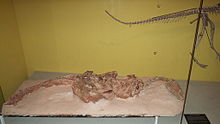Guaibasaurus
Appearance
| Guaibasaurus | |
|---|---|

| |
| Skeletal reconstruction of Guaibasaurus candelariensis as an advanced, Unaysaurus-grade sauropodomorph. Known elements are in white. | |
| Scientific classification | |
| Domain: | Eukaryota |
| Kingdom: | Animalia |
| Phylum: | Chordata |
| Clade: | Dinosauria |
| Clade: | Saurischia |
| Clade: | †Sauropodomorpha |
| Family: | †Guaibasauridae |
| Genus: | †Guaibasaurus Bonaparte et al., 1999 |
| Species: | †G. candelariensis
|
| Binomial name | |
| †Guaibasaurus candelariensis Bonaparte et al., 1999
| |
Guaibasaurus is an
theropod instead.[8] In 2016 Gregory S. Paul estimated it at 2 meters (6.6 ft) and 10 kg (22 lbs), whereas in 2020 Molina-Pérez and Larramendi listed it at 3 meters (10 ft) and 35 kg (77 lbs).[9][10]
Discovery

Guaibasaurus was originally named on the basis of the
articulated and nearly complete left hindlimb, which were discovered in the "Sesmaria do Pinhal 2" locality near Candelária, Rio Grande do Sul, in Brazil, in the upper portion of the Candelária Sequence or the Caturrita Formation.[1]
Later, two additional specimens were referred to G. candelariensis:
articulated and nearly complete postcranial skeleton missing one forelimb, both feet and the neck), and MCN PV 10112 (a not-fully-prepared block containing articulated parts and some isolated elements, including a partial hand). The referred materials were collected from the "Linha São Luiz" locality near the town of Faxinal do Soturno, Rio Grande do Sul, also in the upper portion of the Candelária Sequence or the Caturrita Formation.[2][3]
All specimen were collected in these two localities from the lower portion of the
Life reconstruction
Specimen UFRGS PV0725T is articulated with hindlimbs tucked underneath its body and forelimbs flexed to the side. Although most of the neck is not preserved, the vertebrae at the base of the neck are present in UFRGS PV0725T and curve to the left, suggesting the entire neck was curved toward the left side of the body. The posture of this skeleton is similar to the resting position of birds, and is otherwise primarily known from advanced
dinosauriform Saltopus. Like living birds, Guaibasaurus may have rested in this position to conserve body heat.[4]
Guaibasaurus was first named by
Rio Guaíba hydrographic basin where the holotype was found as a part of the "Prό-Guaíba Project", a scientific program supporting research on fossils from the Triassic period. The specific name is named after Candelária, a city near the fossil locality in which the holotype was found.[1]
Classification

Saturnalia to be very similar to it, and placed the two in the Guaibasauridae which was found to be a primitive saurischian group. Bonaparte found that these forms may have been "prosauropods" (primitive sauropodomorphs), or an assemblage of forms close to the common ancestor of the sauropodomorphs and theropods. Overall, Bonaparte considered that both Saturnalia and Guaibasaurus were more theropod-like than "prosauropod"-like.[2]
More recent
cladistic analyses have disagreed on the placement of Guaibasaurus. Some analyses have found it to be a basal theropod,[3][12] while others consider it a basal sauropodomorph.[5][6] Other members of "Guaibasauridae" (such as Saturnalia) are generally considered to be very basal sauropodomorphs, and may or may not form a clade with Guaibasaurus.[13][14][15][16] An article depicting a novel phylogenetic hypothesis for silesaurids also recovers Guaibasaurus as a sauropodomorph, but close-related to the coeval Unaysaurus and Macrocollum, rather than early forms such as Saturnalia.[7] Thus, Unaysauridae is a junior synonym of Guaibasauridae in this proposal. This result was corroborated in the description paper of the theropod Erythrovenator jacuiensis.[17]
References
- ^ a b c d José F. Bonaparte; Jorge Ferigolo; Ana Maria Ribeiro (1999). "A new early Late Triassic saurischian dinosaur from Rio Grande do Sul state, Brazil". Proceedings of the Second Gondwanan Dinosaur Symposium, National Science Museum Monographs. 15: 89–109.
- ^ S2CID 128421960.
- ^ S2CID 129055255.
- ^ S2CID 140690876.
- ^ S2CID 129244872.
- ^ S2CID 128620874.
- ^ PMID 32842895.
- Pampadromaeus barberenai (Saurischia—Sauropodomorpha) from the Late Triassic Santa Maria Formation of southern Brazil". PLOS One 14(2): e0212543. https://doi.org/10.1371/journal.pone.0212543
- ^ Paul, Gregory S. (2016). The Princeton Field Guide to Dinosaurs 2nd Edition. New Jersey: Princeton University Press. p. 183.
- Bibcode:2020dffs.book.....M.
- .
- ^ Bittencourt Rodrigues, 2010. Revisao filogenetica dos dinossauriformes basais: Implicacoes para a origem dod dinossauros. Unpublished Doctoral Thesis. Universidade de Sao Paulo. 288 pp.
- ISBN 978-1-4051-6933-2.
- PMID 21298087.
- PMID 22096511.
- S2CID 205254710.
- S2CID 229432076.
External links
 Media related to Guaibasaurus at Wikimedia Commons
Media related to Guaibasaurus at Wikimedia Commons Data related to Guaibasaurus at Wikispecies
Data related to Guaibasaurus at Wikispecies

























